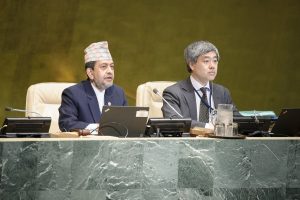Remarks by Mr. Peter Thomson, President of the 71st Session of the General Assembly, delivered by the Vice-President, Durga Prasad Bhattarai, Permanent Representative of the Federal Democratic Republic of Nepal, at the High-Level Event to Mark the 10th Anniversary of the United Nations Declaration on the Rights of Indigenous Peoples
25 April 2017
 I have the honour to deliver the following statement on behalf of the President of the United Nations General Assembly, Peter Thomson, who unfortunately cannot be here today.
I have the honour to deliver the following statement on behalf of the President of the United Nations General Assembly, Peter Thomson, who unfortunately cannot be here today.
Your Excellency Mr. Juan Evo Morales Ayma,
President of the Plurinational State of Bolivia
Honourable Ministers,
Excellencies,
Distinguished Elders,
Ladies and Gentlemen,
Today we meet to mark the 10th anniversary of the United Nations Declaration on the Rights of Indigenous Peoples – a landmark achievement for Indigenous peoples and their relationship with Governments, for the United Nations, and for the advancement of human rights across our world.
The road to achieving the Declaration was not an easy one.
And I would like to pay tribute to the many Indigenous peoples whose tireless work, dedication, and commitment over the years culminated in the adoption of the Declaration in 2007.
The United Nations Declaration on the Rights of Indigenous Peoples was ground-breaking in the collective commitment it captured – a commitment to forge a new relationship between States and Indigenous peoples to recognise historical injustices, and address the intergenerational impacts that are still being felt today.
In the decade that has followed since the adoption of the Declaration, milestones have been reached in our journey to achieve its central aims.
Globally, we have seen a growing awareness of Indigenous peoples, of their rich histories, of their cultural contributions, of their commitment to sustainable development, and of the unique challenges that Indigenous peoples face around the world.
At the country-level, we have seen Governments introduce specific programmes and policies to drive implementation of the Declaration, with elements incorporated into national laws, and even cited in judicial courts.
Indeed, in some cases we have seen the Declaration being used to inform Constitutional reform processes aimed at remedying these documents’ silence on Indigenous peoples’ historical presence, and continuing connection, to the land and waters.
At the United Nations, we have also seen important developments over the last decade, including the establishment of Expert Mechanism on the Rights of Indigenous Peoples, the integration of Indigenous peoples’ into the work of UN agencies, funds and programmes, and, of course, the convening of the historic World Conference on Indigenous Peoples.
While this progress is welcome, the reality is that it has often been inconsistent within countries and uneven across the world.
Indeed, Indigenous peoples continue to face extraordinary vulnerability.
Many suffer the denial of their most basic human rights. While others are subject to poverty, marginalisation, inequality, and social exclusion.
Globalization and urbanization are changing the way communities live, leading to cultural gentrification and irreparable loss of history, beliefs, and language.
While ancestral lands and waters which have long provided livelihoods and sustenance to Indigenous peoples, are being dramatically impacted by climate change, causing deep insecurity and despair.
In this context, if we are to achieve the aims of the Declaration, specific steps must be taken to turn its high-ideals into meaningful action.
Doing so requires that we consider carefully the persistent constraints that hinder our progress; learn from the experiences of others; and use reliable disaggregated data to develop national action plans, policies, strategies and other measures.
Such efforts must promote, protect, and ensure the full realisation of all Indigenous peoples’ rights.
They must prevent and eliminate all forms of violence and discrimination directed at Indigenous peoples, including addressing the intersectional discrimination faced by Indigenous women, children, youth, older persons, and persons with disabilities.
They must raise awareness for Indigenous peoples’ cultures, history, and language, and support efforts to preserve Indigenous heritage, in consultation with Indigenous peoples.
They must serve to empower Indigenous peoples to participate in decisions that affect them, including at the United Nations.
And they must ensure that our work to implement the 2030 Agenda on Sustainable Development not only reach Indigenous communities, but engage Indigenous people as key contributors to sustainable development.
Indeed, just as the Declaration on the Rights of Indigenous Peoples is grounded in human rights, so too is the 2030 Agenda.
We must therefore look at opportunities to take forward achievement of these complementary agendas in a coordinated, effective and efficient way.
Excellencies, Ladies and gentlemen,
If we are to succeed in fulfilling the commitments made under the Declaration on the Rights of Indigenous Peoples, we must begin by forging stronger partnerships between Governments, Indigenous peoples, the United Nations, civil society, the private sector and other key stakeholders.
And these relationships must be built on a foundation of trust.
Let us, the international community, therefore take this opportunity to renew our commitment to Indigenous Peoples, and to working collaboratively to achieve the aims of the Declaration on the Rights of Indigenous Peoples, and to secure a world where the rights of all Indigenous peoples are promoted and protected.
I thank you.

